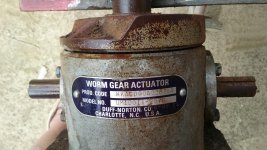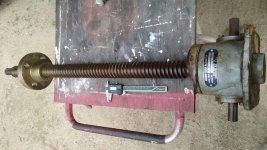Machinst's kid
Plastic
- Joined
- Jan 14, 2008
- Location
- St. Paul, MN
I am interested in finding or fabricating an apple cider press using a hydraulic cylinder. An important criteria includes having the cylinder positioned below the working table. This configuration avoids complications with contamination from leaking or dripping hydraulic fluid. Here is a PAINT sketch of the configuration I have in mind.
The rectangular frame slides vertically relative to the table base. The table base has a working surface supported some distance above the ground on a set of legs. The cylinder piston expands against the underside of the table base and against the lower cross-member of the rectangular frame. The threaded rod at the top engages the work piece and compresses against the top surface of the table base. A spring system (not shown in the figure) can raise the rectangular frame and collapse the hydraulic cylinder after compressing the work piece.
Surely others have seen or built a similar arrangement. Is there a particular name for this sort of configuration?
For cider pressing, the work piece can be a wood slat cylinder or a rack-and-frame apple mash.
This could be made of TIG welded box channel (in aluminum or stainless) or mild steel (painted or powder coated). For the cylinder, I would like something that has about a 16" stroke. Suggestions? I may be able to get a hydraulic output from my old Ford tractor (640).
Ideas? Complications? Feedback? Thanks for thinking about this.
The rectangular frame slides vertically relative to the table base. The table base has a working surface supported some distance above the ground on a set of legs. The cylinder piston expands against the underside of the table base and against the lower cross-member of the rectangular frame. The threaded rod at the top engages the work piece and compresses against the top surface of the table base. A spring system (not shown in the figure) can raise the rectangular frame and collapse the hydraulic cylinder after compressing the work piece.
Surely others have seen or built a similar arrangement. Is there a particular name for this sort of configuration?
For cider pressing, the work piece can be a wood slat cylinder or a rack-and-frame apple mash.
This could be made of TIG welded box channel (in aluminum or stainless) or mild steel (painted or powder coated). For the cylinder, I would like something that has about a 16" stroke. Suggestions? I may be able to get a hydraulic output from my old Ford tractor (640).
Ideas? Complications? Feedback? Thanks for thinking about this.






